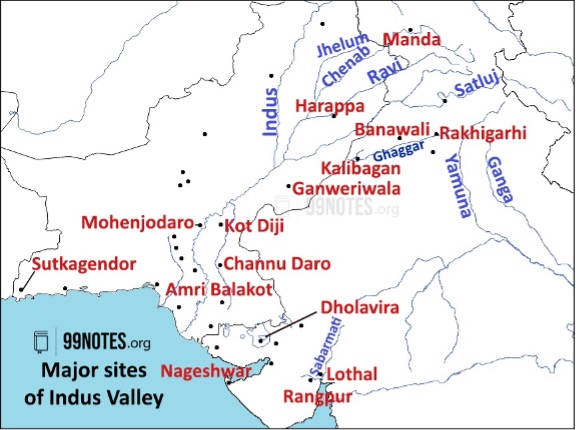Chronology of Excavations of Indus Valley sites
The Harappan civilisation has not been documented in either Indian or foreign ancient texts. It was a largely forgotten civilisation that was discovered by the British in the 19th Century.
In 1829, Masson visited Punjab to gather useful intelligence for the East India Company. He was an enthusiast of Alexander’s military campaigns and chose to visit the same towns that had been featured in Alexander’s campaigns, as noted by the Ancient Greek writers. This is how he discovered Harappa on the bank of Ravi, which Masson thought to be an ancient city of Sagala, as mentioned in Greek writings. Masson made notes and illustrations of Harappa’s rich historical artefacts, many lying half-buried.
The site was plundered for its bricks several times after the annexation of Punjab by the British, especially for the ballast material for the construction of a Railway line connecting Lahore.
The chronology of excavations at Indus Valley sites provides a brief understanding of the geographical and cultural aspects of this civilization. Following is the gist of all the major excavations that have taken place to date in the Indus Valley civilisation.
| Year | Archaeologist | Excavations/Finds |
| 1829 | Charles Masson | He came across Harappa in 1829 and wrongly identified it as Sangala, a city of Alexander’s time. |
| 1856 | Alexander Cunningham
(1st ASI director) |
Visited Harappa & wrongly concluded it to be a Buddhist monastery. |
| 1872-75 | He published about 1st Harappan Seal and said it was not of Indian origin as it depicted a bull without a hump. | |
| 1900s | Daya Ram Sahni
(1st Indian ASI director) |
Discovered many Seals in the area. |
| 1921 | Began excavating Harappa with MS Vats on the banks of the river Ravi. | |
| 1921 | Rakhal Das Banerji, Ernest JH Mackay, John Marshall
(an ASI director) |
– Similar seals were found at Mohenjo-Daro, leading to the conjecture that sites were part of a single archaeological culture.
– Continued excavation by JH Mackay, GF Dales & MS Vats. |
| 1946 | REM Wheeler | Excavates Harappa and Kot Dijian deposits |
| 1955 | SR Rao | Began excavations at Lothal. |
| 1955 | F.A Khan | Identified Kot Diji |
| 1960 | BB Lal & BK Thapar | Began excavations at Kalibagan |
| 1974 | MR Mughal | Began excavations at Bahawalpur |
| 1980 | German & Italian team | Began surface explorations at Mohenjo-Daro. |
| 1986 | American team | Began excavations at Harappa. |
| 1990 | RS Bisht | Began excavations at Dholavira. |
| 2004 | L.S Rao | Began excavations at Bhirrana (Haryana) |
| 2019 | New archaeological findings in Keezhadi (Tamil Nadu) suggested a connection with the Harappan culture | |
| 2022 | S K Manjul | A new round of excavations at Rakhigarhi |

Indus Valley Civilization Sites along Rivers
| Sites | On River/Water body | Location |
| Suktagendor | Dashta | Baluchistan (Pakistan) |
| Chanhudaro | Indus | Sarkand (Pakistan) |
| Kot-Diji | Indus | Khairpu (Pakistan) |
| Rangpur | Madar | Khathiawad (Gujarat) |
| Ropar | Satluj | Ropar (Punjab, India) |
| Alamgirpur | Hindon | Meerut (U.P) |
| Surkotada | Kutch (Gujarat) | |
| Kunal | Saraswati | Hisar (Haryana) |
| Desalpur | Bhadra | Bhuj (Gujarat) |
| Mohanjodaro | Indus | Larkana (Pakistan) |
| Harappa | Ravi | Punjab (Pakistan) |
| Ganweriwala | Ghaggar | Cholistan Punjab (Pakistan) |
| Balakot | Kunhar | Khyber Pakhtunkhwa (Pakistan) |
| Kalibangan | Ghaggar | Hunmangarh(Rajasthan) |
| Lothal | Bhogava-Sabarmati | Ahmedabad (Gujarat) |
| Dholavira | Mandsar and mahar water streams | Kutch (Gujarat) |
| Banawali | Rangoi | Hisar (Haryana) |
| Rakhigarhi | Drishadvati | Hisar (Haryana) |
| Birhana | Ghaggar | Fatehabad (Haryana) |
| Siswal | Ancient Chautang river | Hisar (Haryana) |
| Nageshwar | Gulf of Kutch | Kutch (Gujarat) |
| Manda | Chenab | Jammu and Kashmir |
| Mitalal | Chautang and the Yamuna River | Bhiwani (Haryana) |
| Amri | Indus | Sindh (Pakistan) |


